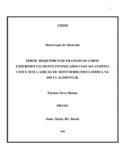| dc.creator | Batina, Patricia Neves | |
| dc.date.accessioned | 2007-04-25 | |
| dc.date.available | 2007-04-25 | |
| dc.date.issued | 2004-08-30 | |
| dc.identifier.citation | BATINA, Patricia Neves. Biochemical profile of broiler chicken experimentally intoxicates by aflatoxin with and without addition of sodic montmorilonite on the feed diet.. 2004. 43 f. Dissertação (Mestrado em Medicina Veterinária) - Universidade Federal de Santa Maria, Santa Maria, 2004. | por |
| dc.identifier.uri | http://repositorio.ufsm.br/handle/1/10167 | |
| dc.description.abstract | This research had as objective evaluated the biochemistry values and the hepatic and renal enzymatic activity pf broiler chicken submitted to experimental intoxication using aflatoxin with and without addition of sodic montmorilonite on the diet. In this study were used 528 Cobb s broiler chickens that were divided in 6 treatments from 1º to 42º day of life: (T1) control: normal diet; (T2) diet with 5 ppm of aflatoxin; (T3) diet with 0,25% sodic montmorilonite; (T4) diet with 5 ppm of aflatoxin + 0,25% sodic montmorilonite; (T5) diet with 0,50% sodic montmorilonite; (T6) diet with 5 ppm of aflatoxin + 0,50% sodic montmorilonite. The treatment (T2) showed significant (P<0.01) decreased levels of uric acid, albumin, cholesterol, creatinine, triglycerides, globulins and total serum proteins. There was statistically significantly increased on alanine aminotransferase (ALT). Aspartate aminotransferase (AST) did not show up important differences among treatments. In (T3) and (T5) there was not variation on the biochemical values when compared with treatment (T1). The sodic montmorilonite (0,50%) (T6) presented the better results on the reduction of the aflatoxin s adsorption when compared with the sodic montmorilonite from (0,25%) (T4). The outcome of this experiment proposed that high level of diet aflatoxin does cause important biochemistry changes on the enzymatic activity of the broiler chicken and also the alternative treatments using sodic montmorilonite may be used to avoid risks caused by feed contamination by aflatoxins. | eng |
| dc.format | application/pdf | por |
| dc.language | por | por |
| dc.publisher | Universidade Federal de Santa Maria | por |
| dc.rights | Acesso Aberto | por |
| dc.subject | Aflatoxina | por |
| dc.subject | Montmorilonita sódica | por |
| dc.subject | Frango de corte | por |
| dc.subject | Perfil bioquímico | por |
| dc.subject | Aflatoxin | eng |
| dc.subject | Sodic montmorilonite | eng |
| dc.subject | Broiler chicken | eng |
| dc.subject | Biochemistry profile | eng |
| dc.title | Perfil bioquímico de frangos de corte experimentalmente intoxicados com aflatoxina com e sem a adição de montmorilonita sódica na dieta alimentar. | por |
| dc.title.alternative | Biochemical profile of broiler chicken experimentally
intoxicates by aflatoxin with and without addition of sodic montmorilonite on the feed diet. | eng |
| dc.type | Dissertação | por |
| dc.description.resumo | Este estudo teve como objetivo avaliar os valores bioquímicos e atividade enzimática hepática e renal em frangos de corte submetidos à intoxicação experimental com aflatoxina com e sem a adição de montmorilonita sódica na dieta. Foram utilizados 528 frangos de corte, da linhagem cobb, divididos em 6 tratamentos do 1º ao 42º dia de vida: (T1) Controle: dieta normal; (T2) Dieta com 5 ppm de aflatoxina; (T3) Dieta com 0,25% montmorilonita sódica; (T4) Dieta com 5 ppm de
aflatoxina + 0,25% montmorilonita sódica; (T5) Dieta com 0,50% montmorilonita sódica; (T6) Dieta com 5 ppm de aflatoxina + 0,50% montmorilonita sódica. O tratamento (T2)com aflatoxina demonstrou significante (P< 0.01) diminuição dos níveis de ácido úrico, albumina, colesterol, creatinina, triglicerídeos, globulinas e proteína plasmatica total. Houve significante aumento da alamina amino transferase (ALT) e a enzima aspartato amino transferase (AST) não foi
significantemente diferente entre os tratamentos. Nos (T3) e (T5) não houve alteração nas dosagens bioquímicas em relação ao (T1) controle. A montmorilonita sódica (0,50%) (T6) apresentou melhores resultados na redução da adsorção da aflatoxina em relação a montmorilonita sódica (0,25%) (T4). Os resultados obtidos, nas condições em que foi realizado este experimento, sugerem que altos níveis de aflatoxina na dieta causam alterações bioquímicas significativas na atividade enzimática de frangos de corte e que o tratamento paleativo com a montmorilonita
sódica pode ser usado para se evitar o risco causado pela contaminação alimentar com aflatoxinas. | por |
| dc.contributor.advisor1 | Lopes, Sonia Terezinha dos Anjos | |
| dc.contributor.advisor1Lattes | http://lattes.cnpq.br/8059723754130756 | por |
| dc.contributor.referee1 | Santurio, Janio Morais | |
| dc.contributor.referee1Lattes | http://lattes.cnpq.br/6316012260769979 | por |
| dc.contributor.referee2 | Alves, Sydney Hartz | |
| dc.contributor.referee2Lattes | http://lattes.cnpq.br/0330782478769631 | por |
| dc.creator.Lattes | http://lattes.cnpq.br/7730310428323456 | por |
| dc.publisher.country | BR | por |
| dc.publisher.department | Medicina Veterinária | por |
| dc.publisher.initials | UFSM | por |
| dc.publisher.program | Programa de Pós-Graduação em Medicina Veterinária | por |
| dc.subject.cnpq | CNPQ::CIENCIAS AGRARIAS::MEDICINA VETERINARIA | por |


